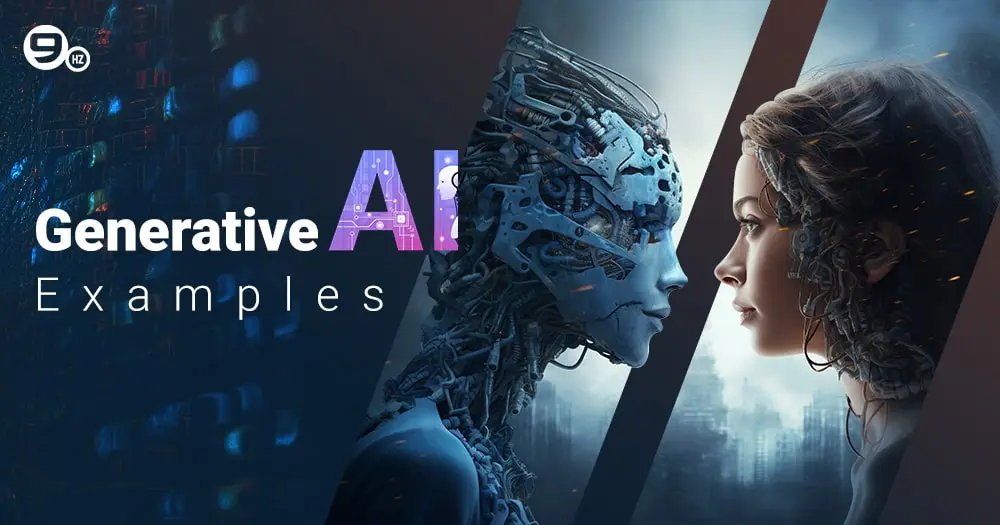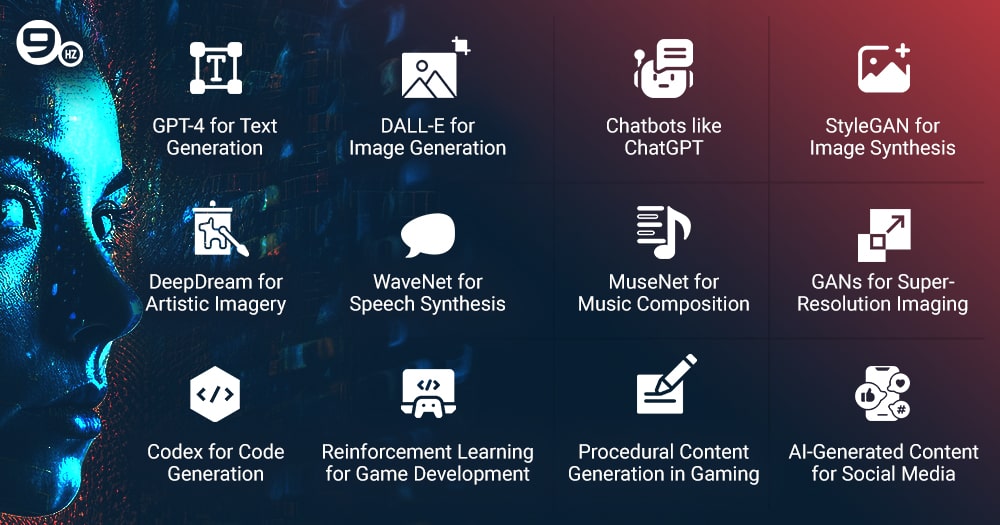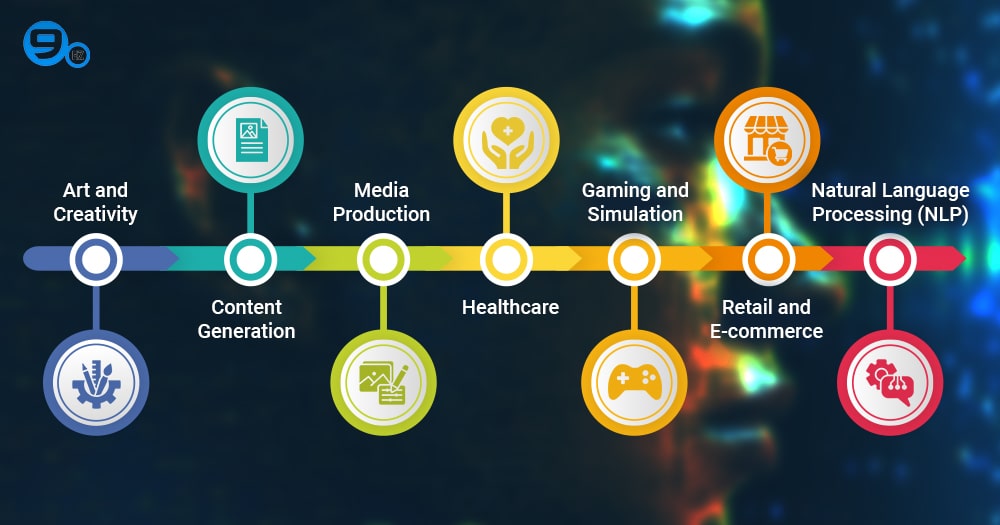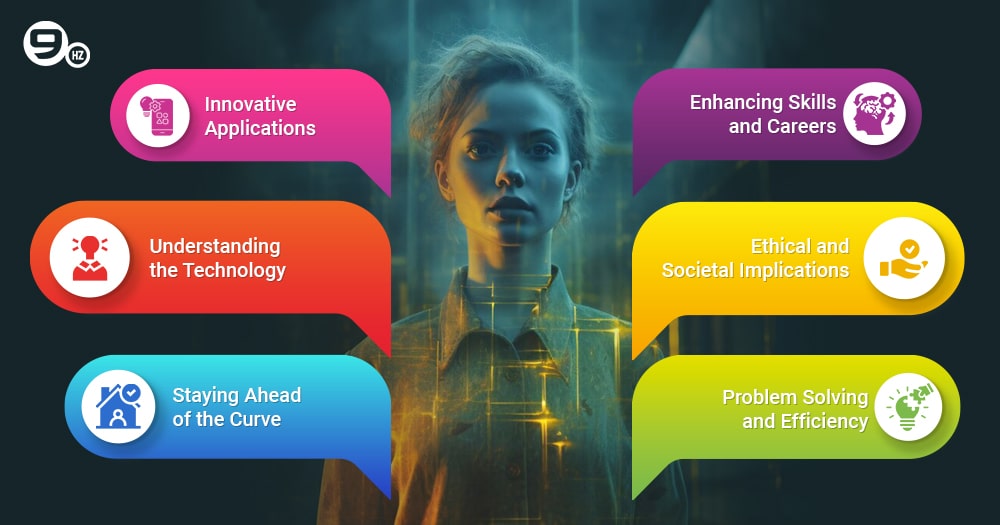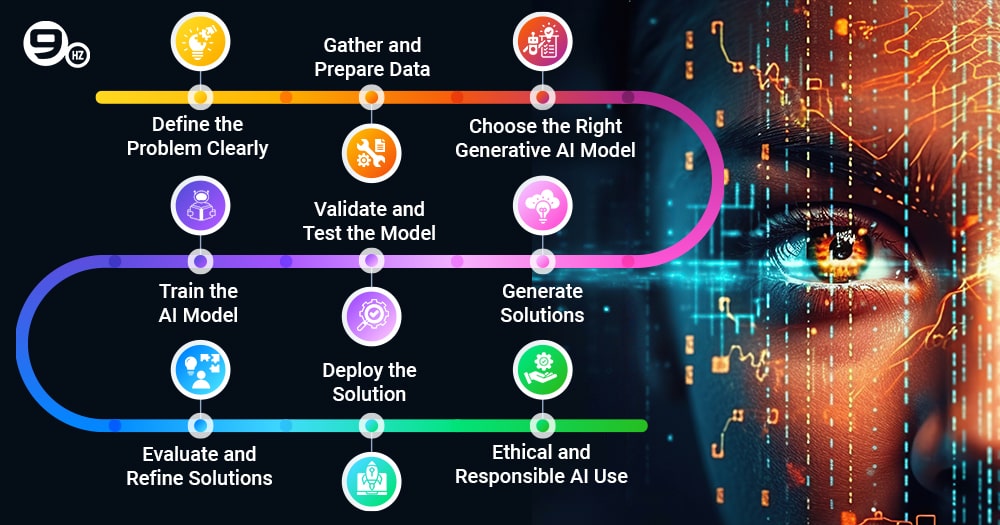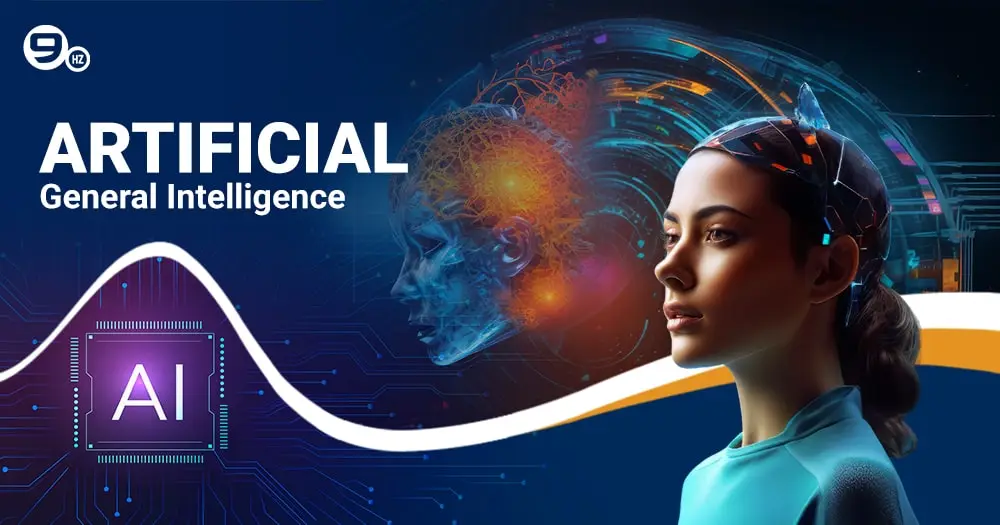Generative AI, a transformative branch of artificial intelligence, has seen remarkable growth and adoption across various industries. Some of the widely used generative AI examples are GPT-4, Dall-E, Chat GPT, Open AI, Gemini, etc. From generating real-like images and videos to composing original music and creating complex architectural designs, generative AI is revolutionizing how content is produced and consumed.
According to a recent MarketsandMarkets report, the generative AI market is expected to surge from $7.9 billion in 2021 to an astounding $51.8 billion by 2028, showcasing an annual growth rate (CAGR) of 57.9%. This rapid expansion underscores generative AI’s significant impact on the global economy. In this blog, we will learn about generative AI examples and their applications, which are important for anyone looking to stay competitive in today’s fast-paced technological landscape.
By exploring the key generative AI examples and their use cases, businesses, and individuals can harness this powerful technology to drive future success. Additionally, we will touch upon the concept of artificial general intelligence and its implications for the future of AI development.
20 Powerful Generative AI Examples
Generative AI is transforming multiple industries by automating creative processes, enhancing user experiences, and accelerating innovation. Generative AI applications are vast, offering new possibilities and efficiencies in various fields.
Here is a detailed note on 20 powerful generative AI examples, highlighting its diverse applications across various domains:
1. GPT-4 for Text Generation
GPT-4 is a language model that generates human-like text based on prompts. It’s used in writing essays, creating dialogue for virtual characters, drafting emails, and producing creative stories. Its versatility in understanding and generating text makes it a powerful tool in content creation and communication.
2. DALL-E for Image Generation
DALL-E is an AI model that creates images from textual descriptions. For example, it can produce an image of “a multi-storyed red house shaped like a shoe.” This technology is valuable in art, marketing, and creative industries, allowing for rapid prototyping and visualisation of concepts.
3. Chatbots like ChatGPT
ChatGPT, built on GPT-4, powers advanced chatbots to engage in detailed, context-aware conversations with users. These chatbots are used in customer service, personal assistants, and educational tools, providing human-like interactions and support.
4. StyleGAN for Image Synthesis
StyleGAN is a generative adversarial network (GAN) that produces high-quality, realistic images. It’s used in creating synthetic portraits, artwork, and other visual content. Its ability to blend styles and attributes makes it a powerful tool in digital art and media.
5. DeepDream for Artistic Imagery
DeepDream is an AI that enhances and modifies images to create dream-like, surreal artwork. It’s often used in digital art to produce unique and intricate visual pieces, showcasing the creative potential of neural networks.
6. WaveNet for Speech Synthesis
Developed by DeepMind, WaveNet generates natural-sounding speech by modelling audio waveforms. It’s used in virtual assistants, automated announcements, and any application requiring high-quality speech synthesis, significantly improving user experience.
7. MuseNet for Music Composition
MuseNet, developed by OpenAI, can compose complex musical pieces in various styles and genres. It aids musicians and composers by generating new melodies, harmonies, and even entire compositions, acting as a creative partner in music production.
8. GANs for Super-Resolution Imaging
GANs can enhance the resolution of images, turning low-quality pictures into high-definition visuals. This technology is valuable in medical imaging, satellite imagery, and photography, where detail and clarity are crucial.
9. Codex for Code Generation
Codex, another OpenAI model, translates natural language into code. It’s used in software development to automate coding tasks, generate snippets, and even build entire applications from verbal descriptions, accelerating the programming process.
10. Reinforcement Learning for Game Development
Generative AI using reinforcement learning can create adaptive and intelligent behaviours in non-playable characters (NPCs) in video games. This enhances gameplay by providing more realistic and challenging interactions for players.
11. BERT for Text Understanding
BERT (Bidirectional Encoder Representations from Transformers) improves natural language understanding for tasks like question answering, sentiment analysis, and text classification. It’s employed in search engines, chatbots, and language-based applications to interpret accurately and respond to user inputs.
12. DeepFake Technology
DeepFakes uses AI to create hyper-realistic fake videos by mapping one person’s facial movements onto another’s. While controversial, this technology is being explored for movie production, virtual reality experiences, and even historical re-enactments.
13. Neural Style Transfer
This technique applies one’s image style to another’s content, creating visually striking content. It’s used in digital art, graphic design, and advertising to merge different artistic styles into a single image.
14. AI-Generated Content for Social Media
AI can generate social media posts, hashtags, and marketing campaigns. It analyses trends and user engagement to produce content that resonates with audiences, helping brands maintain a strong online presence.
15. Procedural Content Generation in Gaming
AI generates game levels, environments, and scenarios procedurally, ensuring unique and diverse experiences for players each time they play. Such technique is used in games like “No Man’s Sky” to create vast, explorable worlds.
16. AI for Drug Discovery
Generative models assist in discovering new drugs by predicting molecular structures and their interactions. This accelerates the development of new medications and treatments, potentially saving years of research and development time.
17. Fashion Design and Virtual Try-Ons
AI generates new fashion designs and allows users to try on clothes virtually. This technology helps fashion designers to innovate and provides consumers with personalised shopping experiences.
18. Story Generation for Movies and Games
AI can generate plot ideas, character arcs, and dialogues for movies and video games. This assists writers and creators in developing engaging narratives and expanding the possibilities of storytelling.
19. Generative Design in Architecture
AI creates designs based on specified constraints and parameters. This approach enables architects to explore innovative structures and optimise designs for functionality and aesthetics.
20. Synthetic Data Generation
AI generates synthetic data to train machine learning models when real data is scarce or sensitive. This technique improves model performance while maintaining data privacy and security.
What Is Generative AI?
A subtype of artificial intelligence called “Generative AI” is related with creating new content, such as literature, music, movies, and photos, by using patterns and examples found in already-existing data. It entails teaching algorithms to comprehend and analyse a sizable dataset, after which they produce new, unique content that is stylistically or structurally comparable to the training data.
Techniques like deep learning, neural networks, and machine learning are used in generative AI to allow computers to generate content that closely mimics human-created output on their own. To create logical and significant content, these algorithms analyse relationships, patterns, and trends found in the training set of data. The models forecast and fill in the missing or next feasible piece of information to create new images, texts or other types of media. Many businesses now turn to a generative AI development company to leverage these advanced techniques, ensuring the creation of high-quality, innovative content tailored to their specific needs and industry standards.
Advantages And Disadvantages Of Generative AI
Here’s a table outlining the advantages and disadvantages of Generative AI:
| Advantages Of Generative AI | Disadvantages Of Generative AI |
|---|---|
| Creativity and Innovation | Ethical Concerns |
| It can generate original and new content, such as art, music, and text. | Potential for misuse in generating deepfakes and misleading information. |
| Efficiency and Automation | Bais and Fairness |
| Automates complex tasks, saving time and resources. | May reproduce or amplify existing biases present in training data. |
| Personalisation and Customization | Quality Control |
| Can create personalised experiences, products, and services. | Generated content may need more accuracy or be of consistent quality. |
| Accessibility and Assistance | Intellectual Property Issues |
| Assists in content creation and idea generation for various fields. | Raises questions about ownership and originality of AI-generated work. |
| Rapid Prototyping and Iteration | Dependence on Data |
| Facilitates quick development and testing of new concepts. | Requires large datasets for training, which may only sometimes be available or high-quality. |
| Enhanced Decision-Making | Resource Intensive |
| It helps in making informed decisions by generating data-driven insights. | High computational power and energy consumption are often needed. |
Generative AI offers significant advantages in creativity, efficiency, and decision-making, transforming various industries by automating complex tasks and personalizing experiences.
Notable Use Cases Of Generative AI And Examples
Generative AI has found numerous notable use cases across various fields. Here are some prominent examples:
1. Art and Creativity
GAN-generated Art: Generative Adversarial Networks (GANs) have been used to create compelling artwork, such as the “Portrait of Edmond de Belamy” by Obvious, which was sold at auction for $432,500 in 2018.
DeepDream: Originally developed by Google, DeepDream uses neural networks to generate surreal and hallucinogenic images based on patterns it recognises within existing images.
2. Content Generation
Text Generation: Models like OpenAI’s GPT (Generative Pre-trained Transformer) can generate coherent and contextually relevant text based on the prompts provided. Applications include automated content creation for journalism, marketing, and creative writing.
Code Generation: AI models can generate code snippets or entire programs based on high-level descriptions or partial code samples, aiding software development.
3. Media Production
Image and Video Synthesis: AI can generate realistic images and videos. For instance, Deepfake technology uses generative models to swap faces in videos, which has implications for entertainment and potentially malicious uses.
Music Composition: AI can compose music in various styles. For example, OpenAI’s MuseNet can generate music in different genres and mix styles.
4. Healthcare
Medical Image Analysis: AI models can generate synthetic medical images to augment training data for machine learning models or simulate medical scenarios for training purposes.
Drug Discovery: Generative models can predict molecular structures with desired properties, potentially speeding up the drug discovery.
5. Gaming and Simulation
Procedural Content Generation: AI can generate game levels, surroundings, and assets, reducing the need for manual creation and enhancing gameplay variety.
Interactive Storytelling: AI-powered systems can generate dynamic narratives and dialogue choices based on player interactions, enhancing the depth and replayability of games.
6. Retail and E-commerce
Personalised Shopping Experiences: AI can generate product recommendations and personalized marketing content based on customer preferences and browsing history.
Virtual Try-On: AI can generate virtual representations of how products (e.g., clothing, makeup) would look on a user, improve the online shopping experience.
7. Natural Language Processing (NLP)
Chatbots and Virtual Assistants: NLP models like chatbots can engage in conversations, answer queries, and provide customer support, often indistinguishable from human interactions.
Language Translation: AI can generate translations between languages, improving accessibility and communication across global markets.
Why Should You Learn About Examples of Generative AI?
1. Innovative Applications
Generative AI has led to groundbreaking applications in art, music, writing, and design. For instance, AI models can generate realistic images, compose music, write coherent essays, and design product prototypes. Learning about these generative AI examples can spark creativity and innovation, encouraging individuals and organisations to explore new possibilities.
2. Enhancing Skills and Careers
Familiarity with generative AI tools and AI applications can improve your skillset, making you more competitive in the job market. Professionals in marketing, graphic design, software development, and content creation can leverage generative AI to improve productivity, creativity, and efficiency.
3. Understanding the Technology
By studying generative AI examples, you gain insights into how these systems work, including the underlying algorithms and data requirements. This knowledge is essential for those looking to develop or implement AI solutions, ensuring they can effectively harness the technology’s potential while recognising its limitations.
4. Ethical and Societal Implications
Generative AI raises important moral and societal questions, such as the potential for deepfakes, data privacy concerns, and the impact on employment. Learning about these generative AI examples helps you stay informed about the broader implications of AI, fostering a responsible and informed approach to its use and regulation.
5. Staying Ahead of the Curve
AI technology is changing rapidly, and it is important to stay informed about the latest advancements and applications for personal and professional growth. By understanding current examples of generative AI, you can anticipate future trends and adapt to the changing technological landscape.
6. Problem Solving and Efficiency
Generative AI can solve complex problems and streamline processes in various domains, from routine tasks automation to generating innovative solutions. Learning about these examples can help you identify opportunities to implement AI in your work or business, improving efficiency and effectiveness.
How to Find Solutions with Generative AI?
As explored in the previous section, generative AI has a various applications, from creative arts to problem-solving in various fields such as science, engineering, and business. Here’s a detailed guide on how to find solutions using generative AI:
Step 1: Define the Problem Clearly
Before leveraging generative AI, it’s crucial to have a well-defined problem. This involves:
- Identifying the Problem: Clearly articulate what needs to be solved. This could be a design challenge, a data prediction, or generating creative content.
- Setting Objectives: Determine the desired outcomes and constraints. What do you hope to achieve with the AI solution?
Step 2: Gather and Prepare Data
Data is the backbone of any AI system. To find solutions with generative AI, follow these steps:
- Collect Data: Gather relevant data that the AI will learn from. This could include text, images, audio, or any other data type pertinent to your problem.
- Clean and Preprocess Data: Ensure the data is clean and well-structured. Remove irrelevant information, handle missing values, and normalise the data as necessary.
- Annotate Data: If needed, label the data to provide additional context for the AI model. This is particularly important in supervised learning scenarios.
Step 3: Choose the Right Generative AI Model
Selecting the appropriate model depends on the nature of your problem:
- Types of Models: Common generative AI models include Generative Adversarial Networks (GANs), Variational Autoencoders (VAEs), and Transformer-based models (like GPT-4).
- Model Suitability: Evaluate the strengths and limitations of each model. GANs are great for image generation, while transformers excel in text generation.
Step 4: Train the AI Model
Training the model involves feeding it data and allowing it to learn patterns and relationships:
- Setting Up Training Environment: Ensure you have the necessary computational resources, such as GPUs or TPUs, for efficient training.
- Hyperparameter Tuning: Adjust the model’s hyperparameters (like learning rate, batch size, etc.) to optimise performance.
- Training Process: Use the prepared data to train the model, monitoring for overfitting or underfitting. This may involve multiple iterations and adjustments.
Step 5: Validate and Test the Model
Validation and testing ensure the model’s accuracy and reliability:
- Validation Set: Use a separate validation set during training to fine-tune the model.
- Testing: After training, evaluate the model on a test set it hasn’t seen before. Measure performance using relevant metrics (e.g., accuracy, F1 score).
Step 6: Generate Solutions
With a trained and validated model, you can now generate solutions:
- Input Data: Provide input data based on the problem requirements. For text generation, this could be a prompt; for image generation, it might be a base image or noise.
- Output Generation: The AI model generates new data or solutions based on the input. Review the output to make sure it meets the quality and relevance criteria.
Step 7: Evaluate and Refine Solutions
The initial solutions might need refinement:
- Evaluation: Assess the generated solutions against your objectives and constraints. Use both qualitative and quantitative measures.
- Iteration: Refine the model or the input data if necessary. This might involve additional training, data augmentation, or tweaking the model architecture.
Step 8: Deploy the Solution
Once satisfied with the solutions, deploy them in the real world:
- Integration: Integrate the AI model into your existing systems or workflows.
- Monitoring: Continuously monitor the model’s performance in the real world to ensure it remains effective and relevant.
- Maintenance: Regularly update the model with new data and retrain to adapt to changing conditions.
Step 9: Ethical and Responsible AI Use
Making sure the responsible use of generative AI is crucial:
- Bias and Fairness: Check for biases in the generated solutions and take steps to mitigate them.
- Transparency: Be transparent about how does generative AI work and the data it was trained on.
- Security and Privacy: Protect the data used and generated by the AI model, ensuring compliance with relevant regulations and standards.
How Generative AI Models Work
A prompt is the first stage in the generative AI process. It can be any kind of input that the AI system is capable of processing, including words, images, videos, designs, musical notation, and other input types. Then, several AI algorithms return new content in response to the commands. Content can include text documents, mathematical solutions, business-related strategies, and realistic fakes created from actual people’s photos or speech.
In earlier days, when generative AI was new, data submission needed an API or other processes that were time-consuming. The developers had to learn new skills to write programs in languages like Python and operate specialist equipment.
These days, generative AI innovators are developing better user interfaces that enable you to express requests in simple terms. You can further customize the results by adding comments to them after receiving a first response.
Conclusion: Generative AI Examples
Generative AI is a game-changer across multiple industries, offering unprecedented capabilities for innovation and efficiency. As there is advancement in technology, its applications will continue to expand, making it crucial for individuals and businesses to stay aware and leverage these tools to drive growth and creativity in 2024 and beyond.
FAQ’s: Examples of Generative AI
Q.1 Is Siri an Example of Generative AI?
Siri is not an example of generative AI. Apple’s virtual assistant, Siri, responds to user inquiries and completes tasks using speech recognition, machine learning, and natural language processing. On the other hand, generative AI is a branch of artificial intelligence that creates new content—like literature, graphics, or music—by using training data. Siri does not create fresh, original content like generative AI models do, even though it makes use of AI technologies to comprehend and react to users.
Q.2 What is an Example of Generative AI Training?
The development of OpenAI’s GPT-3 model is an illustration of generative AI training. An extensive collection of online text, including books, journals, and webpages, was used to train this model. Large volumes of text data are fed into the model throughout the training process, and machine learning methods are used to assist in teaching the model the nuances, syntax, context, and patterns of human language. The model eventually demonstrates the capabilities of generative AI by producing text that is both coherent and contextually appropriate in response to cues.
Q.3 What are the Most Popular Generative AI Tools?
Here are the most popular generative AI tools:
- OpenAI’s GPT-3: A state-of-the-art language model that generates human-like text.
- DALL-E: Another OpenAI model that generates images from textual descriptions.
- Google’s BERT: While primarily for understanding language, BERT has components that contribute to generative tasks.
- DeepArt: an AI program that produces paintings in the style of well-known painters.
- Runway ML: A platform offering various AI tools for artists, designers, and creators.
Q.4 Is Microsoft Copilot Generative AI?
Yes, Microsoft Copilot is an example of generative AI. Integrated into products like GitHub Copilot, it uses models such as OpenAI’s Codex to assist developers by generating code snippets, suggesting code completions, and even creating entire functions based on natural language descriptions. This tool leverages generative AI to streamline coding processes and improve productivity by understanding the context and generating relevant code.
Q.5 What is the Main Goal of Generative AI?
The main goal of generative AI is to create new, original content indistinguishable from that created by humans. Generating text, pictures, music, and other types of media is part of this.. Generative AI enhances creativity, automates content creation, and provides innovative solutions across various industries. By learning from huge data, generative AI models can produce high-quality, contextually relevant outputs that can be used for various applications, from entertainment to education to scientific research.
Great Together!
